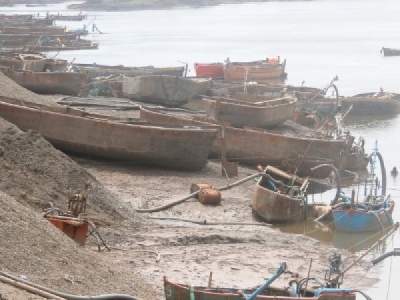
Posted on September 24, 2018
Amos P. Catlin came to Mormon Island in 1849 where he mined and practiced law.
William L. Goggin, agent for the Department of the Post Office on the west coast, asked Catlin for a name for the new post office being set up on Mormon Island.
Catlin offered the name Natoma which was a Maidu Indian name meaning clear water in the local dialect.
The Natoma Water & Mining Company of 1853 was organized by Catlin to bring water to the area from the South Fork of the American River for mining and other uses.
By the end of the 19th century, placer mining along the American River was no longer economically viable on a small scale.
Remaining gold-bearing gravel in the river channel was at a level too deep to be economically recovered through traditional methods.
Dredging the riverbed became the next step in mining.
Around 1902, the Folsom Development Company acquired rights to dredge and placer gravels in the river.
The Natomas Consolidated Company was formed on January 1, 1909, from the consolidation of the Folsom Development Company, Natomas Development Company, El Dorado Gold Dredging Company and the Natomas Vineyard Company.
This reduced the number of companies working the Folsom District down to just two: the Natomas Consolidated and Ashburton Mining Company.
The company built a 36-inch gauge railroad to serve the machines used to crush the rocks from the dredging.
The railroad operated over a temporary track to bring the dredge tailings to the crusher which could then be sold.
Trains of seven cars were loaded by steam shovel near the river and returned to the crusher where their loads were emptied.
As constructed, the crusher used an incline to haul each car up for dumping.
This arrangement was slow and replaced with a ground-level bin and conveyor system allowing for multiple cars to be dumped at once.
The plant had the capability to fill two standard gauge cars of the same graded stone simultaneously.
In the first year of operation, the company’s seven dredgers worked 321.48 acres of land and 13,975,185 cubic yards of gravel.
In 1909, the Natomas Consolidated also took over the holdings of the Cherokee Gold Dredging Company and the Feather River Exploration Company operations near Oroville. These operations gave the company an additional 1,364 acres.
The Natomas Consolidated was then said to be the second largest dredging company in the state.
In 1961, the Natomas Company proposed the American River Parkway to Sacramento County Parks and Recreation.
One thousand acres of land was donated and today serves as hiking trails.
The Natomas Company also donated land for Folsom’s Lembi Park.
On February 12, 1962, the last dredge in Folsom, Natoma No. 6, was shut down.
A model of Natomas Dredger #10 is on display in the Folsom History Museum.
A street in Folsom is named Natoma with another named East Natoma.
Source: FolsomTelegraph





